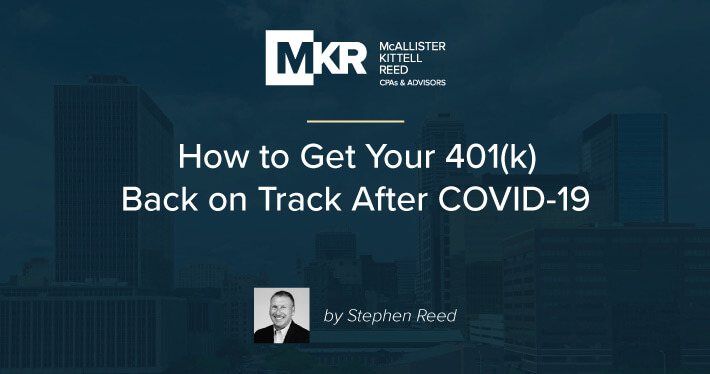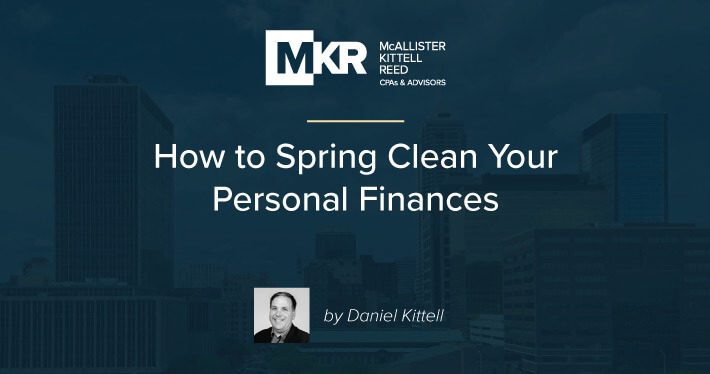
by Stephen Reed | Accounting News, COVID-19, Financial goals, News, Retirement, Retirement Savings
The COVID-19 pandemic has been more than a health crisis—it’s been a financial crisis as well. Business closures, job loss, reduced hours, and limited financial relief led to many savings accounts taking a major hit. As a result, more than 2 million Americans took advantage of the waived penalty for early withdrawal from a 401(k) or other qualifying account set forth in the CARES Act of 2020. This benefit may have been a financial life raft for some, but the move to tap into retirement funds isn’t without short- and long-term impact.
401(k) Early Withdrawal in 2020
Dipping into a retirement savings plan such as a 401(k) before age 59 ½ typically is not without penalty. However, in response to the ongoing COVID-19 crisis, the CARES Act of 2020 made it possible for retirement savers younger than 59 ½ to withdraw, for Covid-related reasons, up to $100,000 from qualified accounts without paying the usual 10% early-withdrawal penalty. For Americans who took a withdrawal, the money is yours and you don’t need to figure out a repayment plan. However, the flip side to this move is that retirement funds you’d planned to live on in the future are now diminished.
Taxes Upon Withdrawal Still Apply
The CARES Act temporarily eliminated the 10% early-withdrawal penalty, but the legislation didn’t pardon the taxes due. While you don’t generally pay taxes on contributions to traditional 401(k)s and IRAs, you do need to report income and pay taxes upon withdrawal. This holds true even though the CARES Act canceled the 10% early-withdrawal penalty for a short time. The temporary rules allow for the distribution to be spread across three years, but you need to account for a least one-third of the taxes due on that amount on your 2020 tax return.
Paying it Back is Recommended
Though you’re not required to pay back this type of withdrawal, experts agree that it’s generally in the saver’s best interest. Doing so allows you to avoid the taxes and to replenish your retirement account. If you pay back the full distribution amount within the three years, you can amend your tax returns and get all the money back paid in taxes.
For those who took a plan loan, you generally have five years to pay it back. You’ll need to be diligent in sticking to the plan’s repayment schedule. A loan that isn’t paid back could be counted as a distribution, therefore taxes (and possibly a penalty) will apply.
Strategize
Savers who took a coronavirus-related distribution have more leeway in developing repayment strategies that best serve their personal situations. Those who took a plan loan have less flexibility, but some repayment strategies could be advantageous, including:
- A mortgage refinance. Given the current low interest rates, refinancing might save a few hundred dollars a month. That savings could then be redirected to repay the 401(k) funds.
- A home equity line of credit. Take advantage of low interest rates, with the ability to pay back the line of credit over at least 10 years.
- Student loans. For savers with college-age children, don’t count out the possibility of relying on federal student loans to help fund college costs while using the freed-up out-of-pocket cash to help pay back funds taken from a 401(k), perhaps in a lump sum. A federal undergraduate loan interest rate of 2.75% through June 30, 2021 combined with conventional thinking that you can borrow to pay for college make a potentially attractive avenue. Just be aware to not overborrow and dig yourself deeper into debt.
Some people may need to apply more than one strategy to return the money to their 401(k), relying on different options that will get them through the next few years. Work with a financial advisor to help determine the best path forward to getting back on track.

by Daniel Kittell | Accounting News, News, Retirement
Legislative passages in 2020, including the SECURE Act, which made changes to beneficiary distributions, and the CARES Act, which included a waiver of required minimum distributions (RMDs), helped to expand the playing field for savers. These two factors, combined with the lowest tax rates in recent history, make for a potentially optimal time for Roth conversions, and many Americans have jumped on board. Is it the right move for you?
The Difference Between Traditional and Roth IRAs
- Traditional IRA or 401(K): enjoy a tax deduction upon contribution but pay taxes upon withdrawal
- Roth: no tax-deduction upon contribution but enjoy tax-free growth and no additional taxes upon withdrawal
The decision comes down to whether to pay taxes now or later. If only a crystal ball existed in which future tax rates could be known.
What Is a Roth Conversion?
A Roth IRA conversion is when an investor transfers money directly from a traditional IRA or 401(k) to a post-tax account such as a Roth IRA. The move is considered a distribution, and thus is taxed in that year. Due to today’s historically low tax environment, Roth conversions are having their moment in the sun.
Advantages of Converting to a Roth IRA
An essential benefit of converting to a Roth IRA is the potential for lower taxes in the future. While it’s obviously not possible to predict future tax rates, you can likely estimate if you’ll be earning more money, and thus, land in a higher tax bracket. If such is the case, odds are typically in your favor to pay less taxes in the long run than you most likely would with the same amount of money in a traditional IRA. Additionally, contribution withdrawals are tax-free (withdrawals from earnings are not tax-free). However, avoid using a Roth IRA like a bank account as any withdrawn funds today, however small, can impact your future savings.
Transferring to a Roth also means you won’t be required to take minimum distributions (RMDs) once you reach age 72. If you’re able to keep the funds in the account, you can watch it grow tax-free, and you would have the option to pass the money to your heirs.
Disadvantages of Converting to a Roth IRA
The biggest deterrent for a Roth IRA is the potentially immense tax bill. If, for example, an investor has $100,000 of pre-tax dollars in a traditional IRA and falls within the 24% tax bracket, the investor would owe $24,000 in taxes, due upon their next quarterly tax bill. Additionally, if the investor is under age 59 ½ and uses the IRA funds to pay the tax bill, they’ll also pay a 10% early withdrawal penalty on that distribution. In other words, be sure you have the liquid assets to cover the tax bill as a result of the conversion.
To Convert or Not to Convert?
If your taxes rise due to government increases, or you begin earning more money and land in a higher tax bracket, a Roth IRA conversion could save you substantial money in taxes in the long run. However, there’s a potential for a hefty tax bill that can be complicated to calculate, especially if you have other IRAs funded with pre-tax dollars, so if you think it might be a good move, it’s best to consult with a tax advisor on your specific circumstances.

by Daniel Kittell | News, Tax, Tax Planning - Individual
Spring cleaning isn’t just for closets, windows, and garages. After tax season is a great time to take a look at your personal finances and spending habits, and make adjustments where needed.
Organize Spending Habits
Take stock of your spending routines and target changes you want to make. Always treat yourself to a latte on Fridays? Meet friends for dinner on Saturdays? How about using coupons or promo codes before the expiration date for FOMTS (Fear Of Missing The Sale)? When you take a keen eye to your spending habits, you’ll be able to spot target areas where your spending reflects nothing more than routine. Now is the time to change up that routine to better reflect your financial goals moving forward.
Polish Your Budget
If you have no budget to dust off, now is the time to create one. Come up with a plan for how you want to save and spend your money, and track your spending habits to help reach your financial goals. The key is to be consistent and stay on budget. Make sure you’re polishing—er, updating—your budget monthly or even weekly.
Catch Up on Late Payments by Turning Trash into Dollars
Are you behind on any payments? Now is the perfect time to slow down and work on a plan to pay things off. Tried-and-true methods for getting some quick cash to help jumpstart this plan is to host a garage sale, post unwanted items on your local Facebook Marketplace, or sell on eBay. A spending freeze—a temporary pause on purchasing anything but essentials—can also help with with saving funds for paying off old bills.
Pare Down Debt
Staying in debt is like trying to swim against the current: you might be moving your arms and kicking your feet but you’re not moving forward. Now is the time to draft a debt repayment plan: make a list of all your debts and rank them in the order you want to pay them off (some people rank from lowest to highest amount owed, while others rank from highest to lowest interest rate). Whichever way you choose, build your plan into your budget, focus on one debt at a time, stay diligent, and watch your debt diminish each month.
Clean out clutter
In most cases you only need to hold onto your tax returns documents for three years, but the IRS has up to six years to initiate an audit if you’ve neglected to report at least 25% of your income. For this reason, taxpayers who receive multiple 1099s from a variety of income sources might want to hold onto documents for at least six years as it can be easy to miss or overlook reporting some income. Keep documents for seven years if you filed a claim for worthless securities or a bad debt deduction.
Maintenance Cleaning: Plan for your Future
Now is the time to plan for your financial future by creating or updating a financial plan with clear goals set on a timeline. A certified CPA or financial planner can help you identify areas of improvement and keep you on track to meet your financial goals.

by Pete McAllister | News, Retirement, Tax Planning - Individual
You don’t need a high-bracket income when it comes to saving more for retirement. What you need, regardless of income level, is discipline. The following tips can help average workers save more and build the kind of wealth that will support them after leaving the workforce.
Automate the Process
A lot of employers offer the option of diverting a percentage of your paycheck directly into your 401(k) account. This takes the guesswork and mental energy out of saving for retirement and puts the process on autopilot. And employers will often match your contribution up to a certain percentage.
Contribute to an IRA
If you don’t have access to an employer-sponsored account, or want something in addition to your 401(k) account, you might think about opening an individual retirement account. You can contribute up to $6,000 per year ($7,000 for those 50 years and older) to an IRA. Keep in mind, while single employees are able to contribute the maximum to a 401(k) and an IRA in the same year, married couples may have some limitations if both participate in a work-sponsored plan. The rules may also be slightly different for a Roth IRA account.
Be Resourceful
Part-time gigs and side hustles are more popular than ever thanks to the internet and smart phones. If you’re diligent with saving the earnings from a secondary income, it can grow over time. You can also use the funds from side gigs to pay off debt, which will open up your budget to allocate more for retirement savings. For example, bringing in an extra $100 a week equals out to $5,200 a year. From selling your possessions on eBay or Facebook Marketplace to offering a service such as dog walking, car detailing, or tutoring, the possibilities of earning extra income are dependent upon your time, talents, and abilities, but the monetary results have real potential to make an impact on your financial future.
Take Control
According to a 2016 study by U.S. Bank, nearly three out of five American families don’t utilize a budget, but a planned budget can cut down on excessive spending and keep your finances in check on a weekly or monthly basis. Impulse buys (no matter how large or small), add up, as do regular dinners out, pressure to keep up with the Joneses, and unforeseen expenses that crop up here and there. Without a budget and a plan for dealing with the unexpected, it won’t take long for your financial grip to unhitch, sometimes leading to seemingly unsurmountable debt. And debt has the power to undermine your retirement savings potential, either temporarily or for much longer.
With free online budgeting plans, myriad ways to earn some extra income, and a commitment to saving, almost anyone can make saving for retirement an attainable goal.
by Stephen Reed | Estate Planning - Individual, News, Retirement, Tax Planning - Individual
For many, even hearing the word investing seems like a frightening proposition filled with great risk and little reward. While investing your hard earned money certainly involves patience and a willingness to learn some key principles, it does not have to be the intimidating process that many make it out to be. According to research, there are four concerns people often cite when choosing not to invest: lack of knowledge or experience, lack of pricing transparency, distrust of the financial industry and the sheer complexity of investing. Below, we discuss ways to conquer each of these concerns and begin investing well.
LACK OF KNOWLEDGE/EXPERIENCE
We can’t sit here and act like investing is a walk in the park. It takes time, patience and at least a general understanding of some finance and investment principles. However, you do not need to have your MBA or have worked in finance for 10 years to grasp the fundamentals of investing. Luckily, we live in an age where you have a wealth of knowledge at your fingertips. A simple internet search can return articles, blogs, podcasts and more that discuss concepts such as long-term compounding of returns or diversification to lower risk. Solid research combined with common sense can put you well on your way to investing sensibly.
LACK OF PRICING TRANSPARENCY
Surely, there are often additional charges, such as fixed index annuities and variable annuities, that can seem confusing or excessive when considering the cost of investing. However, there are plenty of investment structures out there with clearly defined and labeled fees. Sites like morningstar.com allow you to search for investment quotes and discover the annual expenses and sales charges associated with that fund, providing you with a clear directive and comparison to invest where it makes the most sense for you.
DISTRUST OF THE FINANCIAL INDUSTRY
Markets shift on a daily, sometimes even hourly basis, and there are financial advisers out there who take advantage of people’s lack of knowledge, so while a dose of skepticism may be healthy when you begin investing, it should not stop you entirely. If you understand upfront that the markets will indeed fluctuate, sometimes dramatically, so you must remain patient, and know that every investment firm may not have your best interest in mind, you will enter the market cautiously and avoid falling into unknown investment traps.
COMPLEXITY OF INVESTING
Many financial firms will advise a plan of constantly scanning the market and jumping in and out of funds based on new data to be the smartest investor, a process that truly does sound complicated and confusing. However, while this process may work for some, it is not a one-size-fits-all formula. There are a variety of options, from total stock or bond market index funds to target fund portfolios, where you can build wealth for your future with less hassle and constant shifting.
Many let the fear of failure stop them from even trying, but you don’t have to let your fears control you. Be smart, consider your options and do some solid research to mitigate uncertainties, then get those feet wet and start planning and investing for your future, today.




